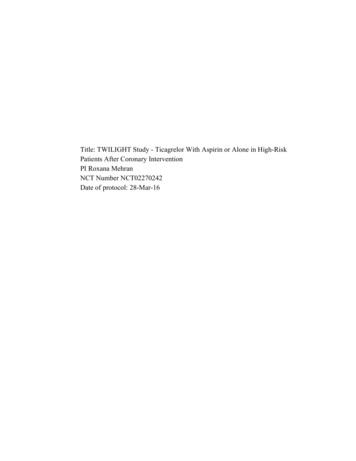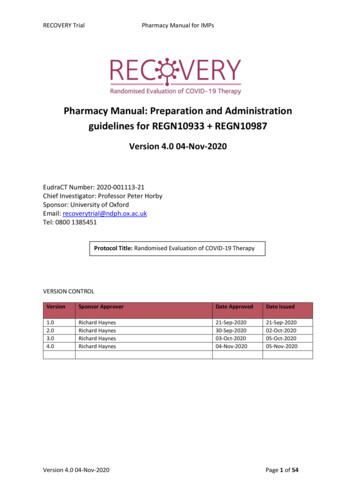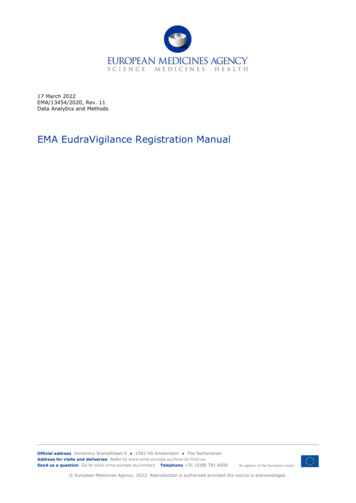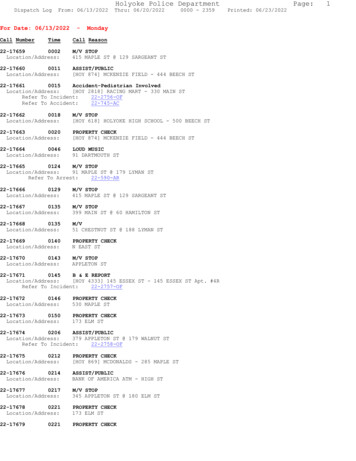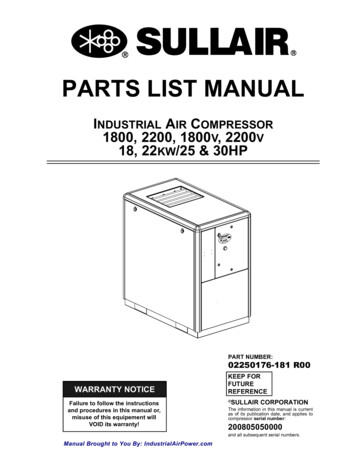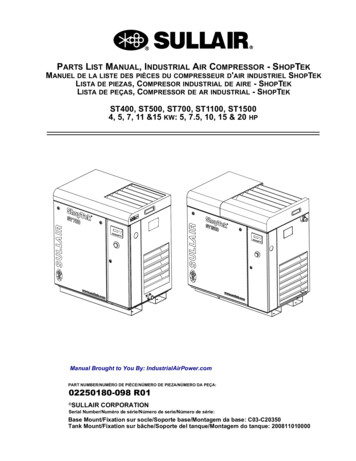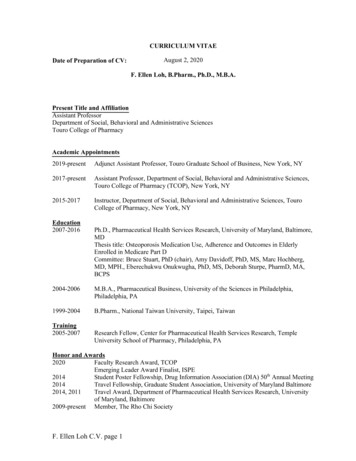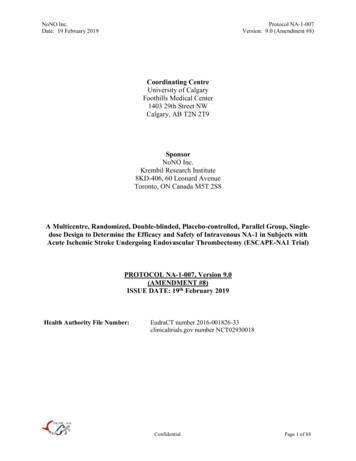
Transcription
NoNO Inc.Date: 19 February 2019Protocol NA-1-007Version: 9.0 (Amendment #8)Coordinating CentreUniversity of CalgaryFoothills Medical Center1403 29th Street NWCalgary, AB T2N 2T9SponsorNoNO Inc.Krembil Research Institute8KD-406, 60 Leonard AvenueToronto, ON Canada M5T 2S8A Multicentre, Randomized, Double-blinded, Placebo-controlled, Parallel Group, Singledose Design to Determine the Efficacy and Safety of Intravenous NA-1 in Subjects withAcute Ischemic Stroke Undergoing Endovascular Thrombectomy (ESCAPE-NA1 Trial)PROTOCOL NA-1-007, Version 9.0(AMENDMENT #8)ISSUE DATE: 19th February 2019Health Authority File Number:EudraCT number 2016-001826-33clinicaltrials.gov number NCT02930018ConfidentialPage 1 of 88
NoNO Inc.Date: 19 February 2019Protocol NA-1-007Version: 9.0 (Amendment #8)Table of Contents1 GENERAL INFORMATION . 21.1 SIGNATURES OF APPROVAL . 21.2 LIST OF ABBREVIATIONS. 82 STUDY SYNOPSIS . 113 COORDINATING CENTRE, SPONSOR, INVESTIGATORS AND FACILITIES . 184 BACKGROUND INFORMATION . 204.1 RATIONALE . 204.2 THE NEUROPROTECTANT, NA-1 . 204.3 SUMMARY FROM NONCLINICAL STUDIES AND CLINICAL TRIALS . 214.3.1 NONCLINICAL STUDIES224.3.2 CLINICAL TRIALS254.4 SUMMARY OF KNOWN POTENTIAL RISKS AND BENEFITS . 274.4.1 PHASE 1 STUDY274.4.2 PHASE 2 STUDY (ENACT)274.4.3 SUMMARY OF SAFETY OF NA-1284.5 DESCRIPTION OF AND JUSTIFICATION FOR THE ROUTE OF ADMINISTRATION, DOSAGE, DOSAGEREGIMEN AND TREATMENT PERIOD . 284.6 TARGET PATIENT SELECTION . 284.7 ENDOVASCULAR ACUTE STROKE THERAPY . 294.8 IMAGING AS A BIOMARKER FOR PATIENT SELECTION . 305 TRIAL OBJECTIVES . 325.15.25.35.4PRIMARY OBJECTIVE . 32SECONDARY OBJECTIVES . 32TERTIARY OBJECTIVES . 32LEADING SAFETY OBJECTIVES . 326 TRIAL DESIGN . 336.1 OUTCOMES . 336.1.1 PRIMARY EFFICACY OUTCOME336.1.2 SECONDARY EFFICACY OUTCOMES336.1.3 TERTIARY OUTCOMES336.1.4 SAFETY OUTCOMES OF SPECIAL INTEREST346.2 RANDOMIZATION AND BLINDING . 356.3 PROCEDURE FOR BREAKING THE RANDOMIZATION CODE . 366.4 TREATMENT . 376.4.1 DOSAGE FORM, ACCOUNTABILITY AND LABELING376.4.2 DISPOSITION OF STUDY DRUG SUPPLIES376.5 STUDY DRUG MONITORING . 386.6 CASE REPORT FORMS . 386.7 PROCESS, TIMING AND QUALITY ASSURANCE METRICS. 387 SELECTION AND WITHDRAWAL OF SUBJECTS . 397.1 STUDY ENROLMENT PROCESS . 397.2 INCLUSION CRITERIA . 39ConfidentialPage 3 of 88
NoNO Inc.Date: 19 February 2019Protocol NA-1-007Version: 9.0 (Amendment #8)7.3 EXCLUSION CRITERIA . 408 TREATMENT OF SUBJECTS . 428.1 STUDY INTERVENTIONS. 428.1.1 ADMINISTRATION OF STUDY DRUG428.2 INTERVENTIONS . 438.2.1 ENDOVASCULAR INTERVENTION438.3 GUIDELINES-BASED MEDICAL/STROKE UNIT CARE . 438.4 SPEED OF INTERVENTION. 458.5 CONSENT PROCESS . 458.6 BASELINE CLINICAL AND LABORATORY EVALUATIONS . 468.7 IMMUNOGENICITY SUBSTUDY . 468.7.1 IMMUNOGENICITY SAMPLE COLLECTION468.7.2 IMMUNOGENICITY SAMPLE STORAGE AND SHIPMENT478.8 PHARMACOKINETICS SUBSTUDY . 478.8.1 PK SAMPLE COLLECTION478.8.2 PK SAMPLE STORAGE AND SHIPMENT478.9 BRAIN AND NEUROVASCULAR IMAGING . 488.10 STUDY DRUG ADMINISTRATION . 488.11 EVALUATIONS FOLLOWING RANDOMIZATION . 488.12 IMAGING . 498.13 CRITERIA FOR DISCONTINUATION FROM THE STUDY . 499 ASSESSMENT OF EFFICACY . 509.19.29.39.49.59.69.79.89.9THE MODIFIED RANKIN SCALE . 50THE NATIONAL INSTITUTES OF HEALTH STROKE SCALE . 50BARTHEL INDEX . 50MORTALITY RATE . 50EQ-5D-5L. 50VOLUME OF STROKES . 51COGNITIVE OUTCOMES. 51PHARMACOKINETICS ASSESSMENT. 51ADDITIONAL ASSESSMENTS . 5110 ASSESSMENT OF SAFETY . 5310.1 ADVERSE EVENT DEFINITIONS . 5310.2 CLINICAL MANAGEMENT OF ADVERSE EVENTS . 5510.2.1 EARLY STUDY DRUG CESSATION5510.2.2 TREATMENT OF HYPOTENSION5510.2.3 INCREASES IN HISTAMINE5610.2.4 HYPERGLYCEMIA5610.3 IDENTIFICATION OF ADVERSE EVENTS BY THE INVESTIGATOR . 5610.4 REPORTING OF ADVERSE EVENTS. 5710.5 REPORTING OF SERIOUS ADVERSE EVENTS . 5710.5.1 REPORTING BY THE INVESTIGATOR5710.5.2 REPORTING SAES TO THE HEALTH AUTHORITIES AND ETHICS COMMITTEES5810.6 ADDITIONAL SAFETY ASSESSMENTS . 5810.6.1 VITAL SIGNS5810.6.2 BIOCHEMISTRY AND HEMATOLOGY59ConfidentialPage 4 of 88
NoNO Inc.Date: 19 February 201910.710.810.910.10Protocol NA-1-007Version: 9.0 (Amendment #8)12-LEAD ELECTROCARDIOGRAM MONITORING. . 59CONCOMITANT MEDICATIONS . 59SAFETY AND DATA REVIEW . 59FOLLOW-UP AND REPORTING OF PREGNANCIES . 5911 STATISTICS . 6111.1 SAMPLE SIZE CONSIDERATIONS . 6111.2 ANALYSIS POPULATIONS . 6111.2.1 ITT POPULATION6111.2.2 PER PROTOCOL POPULATION6111.3 ANALYSIS OF PRIMARY EFFICACY OUTCOME . 6111.4 KEY SECONDARY OUTCOME ANALYSIS. 6211.5 ANALYSIS OF SECONDARY EFFICACY OUTCOMES . 6311.5.1 MODIFIED RANKIN SCALE – SHIFT ANALYSIS6411.5.2 NATIONAL INSTITUTES OF HEALTH STROKE SCALE6411.5.3 BARTHEL INDEX6411.5.4 MORTALITY RATE6411.5.5 MODIFIED RANKIN SCALE – 0-1 DICHOTOMY ANALYSIS6411.6 ANALYSIS OF TERTIARY EFFICACY OUTCOMES . 6411.6.1 EQ-5D-5L6411.6.2 VOLUME OF STROKE6411.6.3 COGNITIVE OUTCOMES6411.6.4 MRS AT 30 DAYS6511.6.5 PHARMACOKINETICS6511.7 ADJUSTMENT FOR COVARIATES AND SUBGROUP ANALYSES . 6511.8 HANDLING OF MISSING, UNUSED AND SPURIOUS DATA . 6511.9 ANALYSES OF SAFETY . 6511.9.1 SAES6511.9.2 MORTALITY6611.9.3 AES6611.9.4 VITAL SIGNS6611.9.5 LABORATORY AND 12-LEAD ECG RESULTS6611.9.6 PRIOR AND CONCOMITANT MEDICATIONS6611.10 INDEPENDENT DATA MONITORING COMMITTEE. 6612 DIRECT ACCESS TO SOURCE DATA/DOCUMENTS. 6813 QUALITY CONTROL AND QUALITY ASSURANCE . 6913.1 AUDITS AND INSPECTIONS. 7013.2 PROTOCOL AMENDMENTS AND REVISIONS . 7014 ETHICS . 7114.1 RESEARCH ETHICS BOARD/INSTITUTIONAL REVIEW BOARD . 7115 DATA HANDLING AND RECORDKEEPING . 7215.115.215.315.4DATA HANDLING . 72INVESTIGATOR FILES/RETENTION OF DOCUMENTS . 72SOURCE DOCUMENTS AND BACKGROUND DATA . 72CASE REPORT FORMS . 73ConfidentialPage 5 of 88
NoNO Inc.Date: 19 February 2019Protocol NA-1-007Version: 9.0 (Amendment #8)15.5 CONFIDENTIALITY . 7316 PUBLICATION AND PRESENTATION POLICY . 7417 ANCILLARY STUDIES POLICY . 7418 DATA-SHARING PLAN. 7519 FINANCIAL CONSIDERATIONS . 7620 APPENDIX 1 – ADDITIONAL GUIDANCE ON IMAGING SELECTION ANDENDOVASCULAR TREATMENT . 7721 APPENDIX 2: DERIVATION OF ASPECTS ON NCCT AND COLLATERALSSCORING ON CTA . 8122 APPENDIX 3 – RANDOMIZATION DETAILS. . 8423 REFERENCES . 8524 INVESTIGATOR’S AGREEMENT . 88ConfidentialPage 6 of 88
NoNO Inc.Date: 19 February 2019Protocol NA-1-007Version: 9.0 (Amendment #8)Tables and FiguresFigure 1: Inhibition of NO production by NA-1 via perturbation of NMDAR-PSD-95interactions [Ca calcium; nNOS neuronal nitric oxide synthase] . 21Table 2-1: Schedule of Assessments. 17Table 10-1: Definitions of AE-Related Terms. 54ConfidentialPage 7 of 88
NoNO Inc.Date: 19 February 20191.2Protocol NA-1-007Version: 9.0 (Amendment #8)List of CPIDMCINRIOMLPermanent Occlusion 3 Pial VesselsAirway, Breathing, CirculationApparent Diffusion CoefficientAcute Ischemic StrokeAnalysis of CovarianceAnalysis of VarianceActivated Prothrombin TimeAdverse EventAcetylsalicylic AcidAlberta Stroke Program Early Computerized Tomography ScoreBeta-human Chorionic GonadotropinBarthel IndexBoston Naming TestBlood PressureCalciumComplete Blood CountCerebral Blood VolumeCode of Federal RegulationsConfidence IntervalCase Report FormClinical Research UnitComputed TomographyComputerized Tomographic Angiography (multiphase or dynamic)Computerized Tomographic PerfusionDiffusion Weighted Imaging’Deep Vein ThrombosisElectrocardiogramElectronic Case Report FormEmergency DepartmentElectronic Data CaptureEuropean Medicines AgencyEndovascular TreatmentFood and Drug AdministrationFluid Attenuated Inversion RecoveryHealth Information ActHealth Insurance Portability and Accountability ActHuman Immunodeficiency VirusIntra-arterialInternal Carotid ArteryIntracranial HemorrhageInternational Conference on Harmonization-Good Clinical PracticeIndependent Data Monitoring CommitteeInternational Normalized RatioInferior Orbitomeatal LineConfidentialPage 8 of 88
NoNO Inc.Date: 19 February RSMRPNa otocol NA-1-007Version: 9.0 (Amendment #8)Institutional Review BoardIntent-to-treatIntraventricular HemorrhageIntravenousLegally Authorized RepresentativeMean Arterial PressureMiddle Cerebral ArteryMiddle Cerebral Artery OcclusionMedical Dictionary for Regulatory ActivitiesMyocardial InfarctionMaximum Intensity ProjectionsMontreal Cognitive AssessmentMagnetic ResonanceMagnetic Resonance ImagingModified Rankin ScaleMagnetic Resonance PerfusionSodiumSodium ChlorideNon-contrast Computed Tomography ScanNon-human Primate Stroke ScaleNational Institutes of Health Stroke ScaleNational Institute of Neurological Disorders and StrokeN-methyl D-aspartateN-methyl D-aspartate ReceptorNeuronal Nitric Oxide SynthaseNitric OxideO’Brien-FlemingOrdinary Least SquaresOdds RatioPercutaneous Endoscopic GastrostomyPotential HydrogenPrincipal InvestigatorPersonal Information and Portable Electronic Documents ActPharmacokineticPermanent Middle Cerebral Artery OcclusionPer ProtocolPost-synaptic Density 95 ProteinResearch Ethics BoardRibonucleic AcidRisk RatioSerious Adverse EventSubarachnoid HemorrhageOxygen SaturationStatistical Analysis PlanSystolic Blood PressureConfidentialPage 9 of 88
NoNO Inc.Date: 19 February SWHOProtocol NA-1-007Version: 9.0 (Amendment #8)Subdural HematomaSunnybrook Hemispatial Neglect ProcedureSystem Organ ClassStandard Operating ProceduresSuspected Unexpected Serious Adverse ReactionTransient Ischemic AttackThrombolysis in Cerebral Infarction ScoreThrombolysis in Myocardial InfarctionTransient Middle Cerebral Artery OcclusionTissue Plasminogen Activator (generic name alteplase)The United States of AmericaWorld Federation of Neurological SurgeonsWorld Health OrganizationConfidentialPage 10 of 88
NoNO Inc.Date: 19 February 20192Protocol NA-1-007Version: 9.0 (Amendment #8)Study SynopsisTrial ObjectivesThe primary objective is to determine the efficacy of theneuroprotectant, NA-1, in reducing global disability in subjects withmajor acute ischemic stroke (AIS) with a small established infarct coreand with good collateral circulation selected for rapid endovascularrevascularization.The secondary objectives are to determine the efficacy of NA-1 in: Trial DesignSubjectsReducing functional dependenceImproving neurological outcomeImproving activities of daily livingReducing mortality rateThe leading safety objectives are to determine the effect ofadministering a dose of 2.6 mg/kg (up to a maximum dose of 270 mg)intravenous (IV) infusion of NA-1 to subject with acute stroke who areselected for endovascular revascularization on serious adverse events(SAEs) and 90-day mortality.This study is a Phase 3, randomized, multicentre, blinded, placebocontrolled, parallel group, single-dose design. Subjects harboring anacute ischemic stroke and who are selected for endovascularrevascularization in accordance with local institutional practices andwho harbor a small established infarct core and with good collateralcirculation will be given a single, 2.6 mg/kg (up to a maximum dose of270 mg) intravenous dose of NA-1 or placebo as soon as they aredeemed to have met the enrollment criteria and with the intention ofstarting administration within 30 minutes of randomization. Therandomization will be by stochastic minimization to balance baselinefactors.Up to 1120 male and female subject will be enrolled.Inclusion Criteria1)2)3)4)Acute ischemic stroke (AIS) for immediate endovascular treatmentAge 18 or greater.Onset (last-seen-well) time to randomization time within 12 hours.Disabling stroke defined as a baseline National Institutes of HealthStroke Score (NIHSS) 5 at the time of randomization.5) Pre-stroke (24 hours prior to stroke onset) independent functionalstatus in activities of daily living with modified Barthel Index (BI) 90 (95 or 100). Patient must be living in their own home,apartment or seniors lodge where no nursing care is required.6) Confirmed symptomatic intracranial occlusion, based on multiphaseor dynamic computerized tomographic angiography (CTA), at oneor more of the following locations: Intracranial carotid T/L, M1middle cerebral artery (MCA). Functionally, when defining the M1or the M2, the bulk of the MCA territory must be ischemic.ConfidentialPage 11 of 88
NoNO Inc.Date: 19 February 2019Protocol NA-1-007Version: 9.0 (Amendment #8)7) Non-contrast computed tomography (NCCT) and CTA* for trialeligibility performed or repeated at ESCAPE-NA1 stroke centrewith endovascular suite on-site.8) Endovascular treatment with declared first endovascular approachas either stent retriever or aspiration device, and intended to beinitiated (arterial access) within 60 minutes of baseline/qualifyingNCCT and to first recanalization of 90 minutes. Study drugintended to be administered within 60 minutes of thebaseline/qualifying NCCT.9) Signed informed consent from subject or legally authorizedrepresentative or, if required to enable inclusion by applicablenational laws and regulations and the applicable independent reviewboards/Ethics Committee requirements for obtaining consent, fromthe investigator after consultation with an independent physicianwho is not otherwise participating in the trial.*As per the List of Abbreviations (Section 1.2), all references to CTAindicate a multiphase or dynamic CTA.Exclusion Criteria1) Evidence of a large core of established infarction defined asASPECTS 0-4.2) Evidence of absence of collateral circulation on CTA (Collateralscore of 0 or 1).3) Intent to use any endovascular device other than a stent retrieveror clot aspiration device or intra-arterial medications as theinitial thrombectomy approach.4) Intent to use any intravenous thrombolytic other than alteplaseif intravenous thrombolysis is planned.5) No femoral pulses, very difficult endovascular access or extremetortuosity of great vessels that is predicted to result in aninability to deliver timely endovascular therapy. Directcommon carotid or radial/brachial/axillary access is permissible.6) Estimated or known weight 120 kg or 45 kg.7) Pregnancy; if a woman is of childbearing potential a urine orserum beta human chorionic gonadotropin (β-hCG) test ispositive, or breastfeeding.8) Severe contrast allergy or absolute contraindication to iodinatedcontrast preventing endovascular intervention, including anycontraindications listed in the prescribing information approvedby local authorities (e.g., patients with decompensated heartfailure as a contraindication for the use of VISIPAQUETM 270in Germany).9) Clinical history, past imaging or clinical judgment suggests thatthe intracranial occlusion is chronic or there is suspectedConfidentialPage 12 of 88
NoNO Inc.Date: 19 February 2019Protocol NA-1-007Version: 9.0 (Amendment #8)intracranial dissection such that there is a predicted lack ofsuccess with endovascular intervention.10) Prior enrolment in the ESCAPE-NA1 trial or prior receipt ofNA-1 for any reason.11) Severe known renal impairment defined as requiring dialysis(hemo- or peritoneal) or if known a creatinine clearance 29mL/min.12) Patient has a severe or fatal comorbid illness that will preventimprovement or follow-up.13) Patient cannot complete follow-up treatment due to co-morbidnon-fatal illness or they are known to be a visitor to the city orany other known reason for which follow-up would beimpossible (e.g. incarcerated in a federal prison).14) Participation in another clinical trial investigating a drug,medical device, or a medical procedure in the 30 dayspreceding study inclusion.CountriesTreatmentCanada, Ireland, Sweden, U.S., South Korea, United Kingdom,Australia, GermanyNA-1 2.6 mg/kg (up to a maximum dose of 270 mg, or matching normalsaline placebo volume) will be administered as a single 10 1 minuteintravenous infusion in the upper or lower extremity using an infusionpump starting after randomization. All subjects will undergo attemptedendovascular recanalization therapy with the intended endovascularapproach being either using a stent retriever or clot aspiration deviceand receive best medical care according to modern acute stroke careguidelines.Stent retrievers or aspiration devices will be used according to currentlocal jurisdictional guidelines.ConsentSigned informed consent will be obtained prior to any protocol-specificprocedures from the subject or legally authorized representative or, ifrequired to enable inclusion by applicable national laws and regulationsand the applicable independent review boards/Ethics Committeerequirements for obtaining consent, from the investigator, afterconsultation with an independent physician who is not otherwiseparticipating in the trial.If the original process involved anyone other than the subject and ifrequired by local standards, consent will be sought for the remainingprocedures from the subject once they are deemed to have regainedcapacity.RandomizationMethodTreatment will be assigned using 1:1 randomization (placebo:NA-1)with a stratification and minimization algorithm to minimize theConfidentialPage 13 of 88
NoNO Inc.Date: 19 February 2019Protocol NA-1-007Version: 9.0 (Amendment #8)contribution of imbalances in baseline factors and non-randomizedtherapies (e.g., alteplase use) to differences between treatment groups.Duration ofTreatmentThis study consists of one 90-day study period for each subject.Subjects will be hospitalized for care after their acute stroke accordingto the current standard of care. Subjects are required to return to clinicon Days 30 and 90 for end-of-study procedures.LaboratoryTestsIn order to support the assessment of patient safety baseline (pre-dose)and post dose hematology and chemistry laboratory tests will becollected.At baseline, and at 24 12 hours after study drug infusion andtermination of EVT blood work will be evaluated which include:complete blood count (CBC), electrolytes, international normalizedratio (INR), activated prothrombin time (aPTT), serum creatinine andserum glucose.Other laboratory or point-of-care testing may be performed at thediscretion of the attending physicians and team.If the subject is female and is of childbearing potential, a pregnancy test(urine or serum point-of-care pregnancy test) must be completed and anegative test result obtained prior to inclusion in the trial.Electrocardiograms will also be collected and reviewed at baseline (predose, unless impeding access to timely intervention) and at 24 hours.Assessment ofEfficacy andPowerThe primary efficacy outcome variable for the pivotal assessment ofefficacy for regulatory submission purposes is the overall proportion ofsubjects experiencing a favorable functional outcome 90 days postrandomization, defined as a score of 0 to 2 on the modified Rankin Scale(mRS). These subjects are defined to be responders. Assuming a 52%overall responder rate for the placebo group, there will be anapproximately 80% power to detect an 8.7% absolute effect differencebetween response rate (proportion of responders, with Day 90 mRS inthe range 0 to 2) with NA-1 and placebo, at alpha level 0.05, 2-sidedwith a planned sample size of 1076 evaluable subjects, randomized 1:1,per group, accounting for a single interim analysis when 600 subjectshave completed their 90 day follow up visit information (600 subjectswith primary endpoint assessments) with O’Brien-Fleming alphaspending function stopping boundary for overwhelming efficacy and anon-binding 1% conditional power futility stopping boundary (EaST V6.3). The sample size will be inflated approximately 4% to N 560 pergroup to account for loss-to-follow-up and drop-outs.The primary hypothesis to be tested is that administration of NA-1 willresult in an increase in the proportion of subjects with independentfunctioning on the mRS (as defined by a score of 0-2) at Day 90. TheConfidentialPage 14 of 88
NoNO Inc.Date: 19 February 2019Protocol NA-1-007Version: 9.0 (Amendment #8)primary analysis will be a Wald test for treatment group difference inthe primary outcome from a logistic regression including treatment andthe following important prognostic factors: intravenous alteplasetreatment, intended initial endovascular approach as well as age, sexbaseline NIHSS score, baseline ASPECTS score, occlusion location andsite.The primary efficacy analysis and secondary endpoint analyses will beconducted on the intent-to-treat (ITT) population, defined as all subjectsrandomized into the trial with grouping by randomized treatment,regardless of treatment actually received. Deceased
MIPS Maximum Intensity Projections . MoCA Montreal Cognitive Assessment . MR Magnetic Resonance . MRI Magnetic Resonance Imaging . mRS Modified Rankin Scale . MRP Magnetic Resonance Perfusion . Na Sodium . NaCl Sodium Chloride . NCCT Non-contrast Computed Tomography Scan . NHPSS Non-human Primate Stroke Scale
